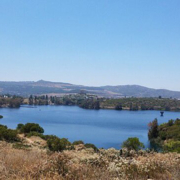The East County Advanced Water Purification Project is moving forward after a new funding agreement was approved.
The program’s partner agencies – Padre Dam Municipal Water District, the City of El Cajon, Helix Water District and the County of San Diego – recently approved the Interim Funding Agreement. The final vote from the County of San Diego took place July 10.
The project is expected to begin producing water in 2025.
Purified water reduces dependence on imported water
The agreement requires each agency to commit $2.35 million ($9.4 million total) toward the program, with the aim to create a new, local, sustainable, and drought-proof drinking water supply using state-of-the-art technology to purify East San Diego County’s recycled water.
“This is an important milestone toward the completion of this innovative and much-needed program, said Allen Carlisle, CEO and general manager of Padre Dam Municipal Water District. “Working together with our partners, we are moving one step closer to reducing our dependence on imported water and putting the mechanisms in place to support our economy and quality of life well into the future.”
Sustainable drinking water project

An artist’s rendering of the new Padre Dam Visitor Center at the East County Water Purification Treatment Center. Graphic: Courtesy Padre Dam Municipal Water District
Once complete, the East County Advanced Water Purification Program will generate up to 11.5 million gallons per day of new drinking water. This represents approximately 30 percent of current drinking water consumption for residents within the Padre Dam service area (Santee, El Cajon, Lakeside, Flinn Springs, Harbison Canyon, Blossom Valley, Alpine, Dehesa and Crest), and the Helix service area (including the cities of Lemon Grove, La Mesa, and El Cajon, and the Spring Valley area). This represents approximately 373,000 residents.
The project will recycle East San Diego County’s wastewater locally, and then purify the recycled water at an advanced water treatment facility using four advanced water purification steps producing water that is near-distilled in quality. The purified water will then be blended with water in Lake Jennings, treated again at the Helix R.M. Levy Water Treatment Plant and then distributed into the drinking water supply.
Industry Day planned for prospective designers and contractors
Next steps for the project include formation of a Joint Powers Authority between Padre Dam Municipal Water District, the City of El Cajon, and the County of San Diego to serve as the governing body for the program.
An industry day is being planned in mid-August to provide notice to prospective designers and contractors on the initiation of a selection process for the progressive design-build packages that will begin posting in Fall 2019.
Partner agencies also continue to pursue grant and loan opportunities to help fund the estimated $528 million project.
The water-recycling project is intended to diversify East County’s drinking water supply and reduce the region’s dependence on imported water. It also helps the region in achieving long-term compliance with the Clean Water Act.
Padre Dam offers tours of the East County Advanced Water Purification Demonstration Project. To schedule a tour or for more information on the East County Advanced Water Purification Program, visit www.EastCountyAWP.com.




 Sweetwater Authority Logo 2019
Sweetwater Authority Logo 2019
